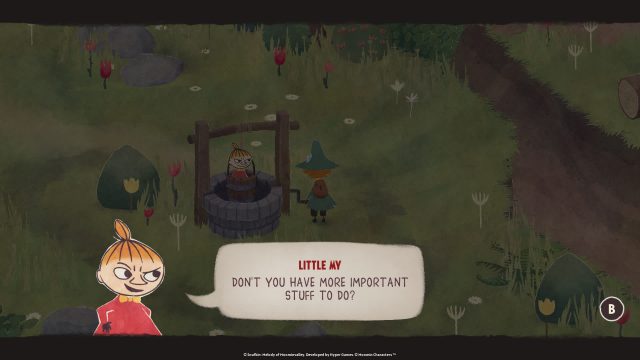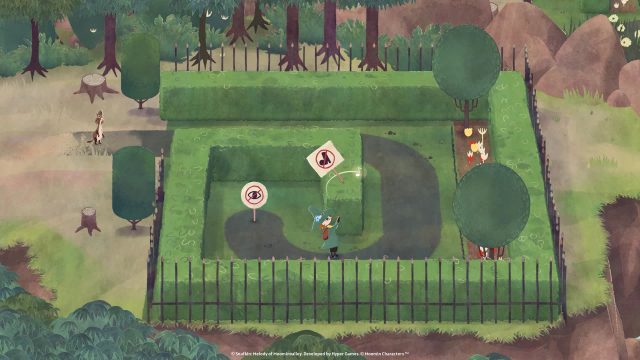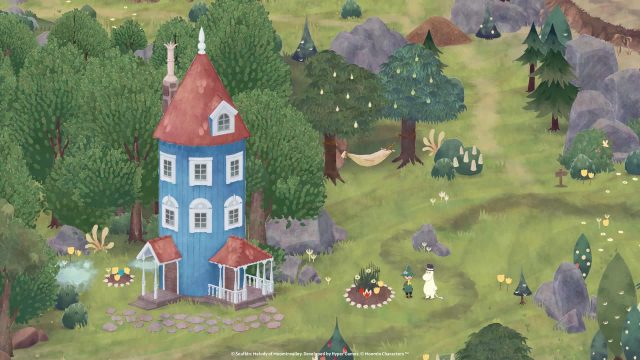It’s Snufkin. You play as Snufkin! But also: beautiful visuals and artistic direction in a game that will be both fresh and familiar to Moomin fans and an imaginative delight for newcomers to the franchise.
Adult players and experienced gamers may find the game lacks challenge, but this is Moomin Valley we’re talking about.
Games give us the ability to play as some of our favorite characters from well known stories. Step into the shoes of the mythical prince of the underworld Zagreus in Hades, the alluring Geralt of Rivia in The Witcher, or the sexy womanizer James Bond in GoldenEye 007.
While these characters have their appeal and grant a degree of wish fulfillment, there’s no character I’d rather be than Snufkin from Tove Jansson’s imaginative world of Moomin. And who wouldn’t want to be a bit more like Snufkin? He’s the contemplative, anti-materialistic vagabond musician with a hatred for rules and authority. He goes where he wants, he does what he wants, and most importantly knows what he wants and who he is. Snufkin is the embodiment of freedom and easily the most popular character from the Moomin series.
“What is Moomin,” you ask? Hello my fellow American! Or at least not European or Japanese and most definitely not Nordic. The Moomin franchise is the globally recognized work stemming from the creative mind and award-winning, Swedish-speaking Finnish author and illustrator Tove Jansson. Since her first book in 1945, her fantastical world of Moomin has entranced children and adults alike with its books, comic strips, various shows, plays, and merchandise. And now, her work can reach the hands, minds, and hearts of gamers.
The story of Snufkin: Melody of Moomin Valley takes inspiration from multiple works and combines various gameplay elements such as stealth, puzzle solving, and exploration. This game is sure to be enjoyed by players of all ages, longtime Moomin fans, as well as newcomers. The game begins with Snufkin’s annual springtime return to Moomin Valley to find things are not the same. Animals are fleeing the valley, hideous manicured parks with signs and rules litter the valley, the stream has dried up, and Snufkin’s best friend Moomintroll is missing.
Snufkin aims to restore the valley to its previous state by destroying the parks and changes made by the Park Keeper. And, most importantly, find Moomin. While in parks, Snufkin must sneak past or distract police officers in order to remove all the signs, knock over statues, and encourage the police officers to leave. I enjoyed these little moments of anarchy and the sneaking reminded me of Link slipping past castle guards in older Zelda titles.
When you aren’t rebelling against the man, you’re either solving simple puzzles to access new areas or exploring the beautiful areas of the game. While the puzzles aren’t challenging, they aren’t tedious as so many easy puzzles can be in games. This makes the game accessible for all ages while not becoming drudgerous for more seasoned or older players. A walk in the park, you might say. I’d love to use this game as a way to introduce the Moomin series to a niece or nephew or recommend it to someone looking for a cozy, relaxing experience.
Speaking of cozy, that brings us to the visuals. Trove Jansson has a very recognizable, iconic art style and a set of characters who have evolved with interpretation in new media over the years. Hyper Games’ style in Snufkin: Melody of Moomin Valley is familiar and still recognizable while also being fresh. At times, the style reminded me of another classic children’s picture book, Where the Wild Things Are or a Van Gogh painting. Any still or screenshot could easily be used for a picture book, but there are some especially scenic spots that the designers use to encourage you to stop and savor your surroundings. This is completely canonical to the tone of the Moomin books and Snufkin’s character.
But games go beyond the medium of books with the use of motion and sound and both are implemented seamlessly. The soundscape is excellent and brings the environments to life. I could have easily closed my eyes and imagined I was sitting along a stream or walking through a field of flowers just as Snufkin was. Traversing and moving through the environment is easy and natural. Although you won’t be challenged with platforming or evading enemies, the beauty of Moomin Valley means navigating is never boring.
If I had to make any criticisms of the game or its performance on Switch, the easiest thing to point out would be slight framerate drops and occasional lag in the busier areas or moments of the game. At one point, the game froze and I was forced to close and restart. However it barely disrupted my experience. Due to limitations in my current lifestyle, I played exclusively in handheld mode and this issue may not come up when playing in docked mode.
A gameplay element I found to be a bit lacking was the inspiration system. Snufkin is a musician inspired by nature and his wanderings. His artistic process comes from solitary exploration in nature. The game captures this by implementing an inspiration leveling up system. Certain obstacles require Snufkin to play an instrument and be at or above a particular “inspiration level” in order to pass the obstacle. Snufkin must collect enough inspiration to reach the right level in order to continue.
On one hand, I liked how Snufkin collected inspiration by running through bushes, exploring, and helping others. This felt very intune with his character. But on the other hand, the mechanic fell short, coming across as arbitrary. Inspiration is abundantly available and easy to find. Except for when the mechanic is first introduced, I was never below the required play for something I came across. Often, the level requirement felt pointless. I regularly came across creatures requiring a lower level than the character or barrier I had just passed. For example, Snufkin would need to play his harmonica for a level 6 obstruction in order to continue. Beyond it would be something requiring a level 4. What was the point of having lower inspiration level requirements locked behind higher levels?
The mechanic made me wonder if an inspiration currency mechanic would have been more rewarding. Snufkin’s inspiration comes and goes after all and this mechanic would have introduced player decisions on what to use inspiration on and when in addition to making inspiration more valuable and passing barriers or playing for creatures feel more rewarding. However, I can see how this mechanic could lead to players getting stuck in areas, feeling frustrated if they couldn’t find enough inspiration to continue, or making the act of collecting inspiration feel like a chore.
Snufkin: Melody of Moomin Valley is a fresh take on the work of Tove Jansson while still being faithful to the series and its characters. The developers love for Jansson’s creations is apparent throughout the game and this is the perfect step for the characters into a new medium. I enjoyed my short but sweet trip into Moomin Valley and look forward to more Moomin inspired games in the future.
Nintendojo was provided a copy of this game for review by a third party, though that does not affect our recommendation. For every review, Nintendojo uses a standard criteria.




 ShareThis
ShareThis









